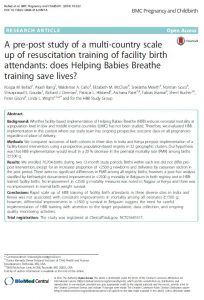
Background: Whether facility-based implementation of Helping Babies Breathe (HBB) reduces neonatal mortality at a population level in low and middle income countries (LMIC) has not been studied. Therefore, we evaluated HBB implementation in this context where our study team has ongoing prospective outcome data on all pregnancies regardless of place of delivery.
Methods: We compared outcomes of birth cohorts in three sites in India and Kenya pre-post implementation of a facility-based intervention, using a prospective, population-based registry in 52 geographic clusters. Our hypothesis was that HBB implementation would result in a 20 % decrease in the perinatal mortality rate (PMR) among births ≥1500 g.
Results: We enrolled 70,704 births during two 12-month study periods. Births within each site did not differ prepost intervention, except for an increased proportion of <2500 g newborns and deliveries by caesarean section in
the post period. There were no significant differences in PMR among all registry births; however, a post-hoc analysis stratified by birthweight documented improvement in <2500 g mortality in Belgaum in both registry and in HBBtrained facility births. No improvement in <2500 g mortality measures was noted in Nagpur or Kenya and there was no improvement in normal birth weight survival.
Conclusions: Rapid scale up of HBB training of facility birth attendants in three diverse sites in India and Kenya was not associated with consistent improvements in mortality among all neonates ≥1500 g; however, differential improvements in <2500 g survival in Belgaum suggest the need for careful implementation of HBB training with attention to the target population, data collection, and ongoing quality monitoring activities.